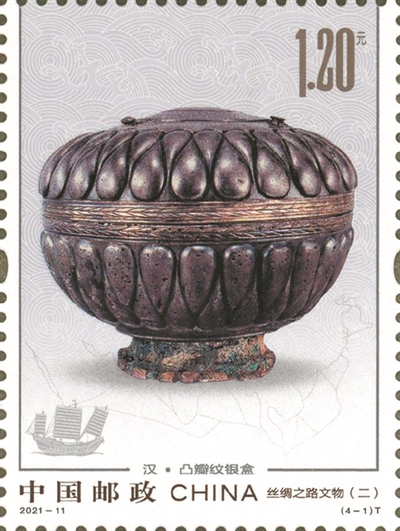
June 12, 2021 is our "Cultural and Natural Heritage Day". On the same day, China Post Group Corporation issued a set of 4 special stamps of "Silk Road Cultural Relics (II)", and the stamp patterns were Han Convex Petal Pattern Silver Box, Tang Changsha Kiln Blue Glaze Brown Spot Molded Appliqué Date Pattern Holding Pot, Five Dynasties and Ten Kingdoms Persian Peacock Blue Glazed Pottery Vase, Song Longquan Kiln Blue Glazed Chrysanthemum Petal Plate, and the full set of stamps had a face value of 4.80 yuan.
Guangzhou Daily all-media reporter Bu Songzhu correspondent Yue Wen Travel Xuan
Photo: Courtesy of the Museum of the King of Nanyue in the Western Han Dynasty
All are precious cultural relics of the "Sea Silk Road"
These 4 stamps select 4 precious cultural relics of the Maritime Silk Road (pictured). Among them, the Han convex petal silver box is a representative "Hai Silk" cultural relics excavated in Guangdong Province, excavated from the tomb of King Wen of Nanyue in Guangzhou, and is now stored in the Museum of the King of Nanyue in the Western Han Dynasty.
The silver box is flattened and bulbous, with garlic clove-shaped convex patterns punched out of the lid and body, and a turn-like band at the junction of the lid, with a very thin gilded surface. Its shape, ornamentation and production process are very different from the traditional Chinese style, similar to the gold and silver ware of the Persian Empire in West Asia, which was imported from the Maritime Silk Road and is an imported product.
In addition, the Changsha kiln blue glaze brown spot mold print appliqué date pattern holding pot is now in the Changsha Copper Official Kiln Museum, the Persian peacock blue glazed pottery vase is now in the Fujian Museum, and the Longquan kiln blue glaze chrysanthemum petal plate is now in the National Museum of China.
The stamp design takes cultural relics as the main element, and the background is the waves, ancient sailing ships and major routes, which fully reflects the cultural exchanges between the East and the West carried by the ancient Maritime Silk Road, and further promotes the "Sea Silk" culture. Stamps are sold at designated postal outlets nationwide, philatelic network halls, China Post mobile phone clients, etc., with a sales period of 6 months.
Three of the "special stamps" are closely related to Guangzhou
After learning the news, the reporter interviewed Wu Lingyun, director of the Museum of the Nanyue King of the Western Han Dynasty, for the first time.
Wu Lingyun introduced, "Silk Road Cultural Relics (II)" three of the special stamps are closely related to Guangzhou, the silver box is needless to say, as the earliest "imported product" in the Lingnan region, it is also one of the earliest overseas imported products found in China, the shape and ornamentation of this column petal silver box are very different from the Style of Chinese Han Dynasty artifacts, and similar to the artifacts of the Persian Empire in Iran. The garlic clove pattern of the silver box was pressed by pounding, and the gold and silver ware of this method is generally believed to have originated in Persian culture.
At that time, Changsha kiln porcelain was mainly marketed to the world through the two ports of Guangzhou and Ningbo, Ningbo faced The Korean and Japanese regions, and Guangzhou faced Southeast Asia, the Arab region, and the east coast of Africa.
Another peacock blue glazed bottle is from Fuzhou, the tomb owner Liu Hua is a princess of the Southern Han Dynasty of the fifth generation, and similar artifacts have been excavated from the ruins of the Palace Office of the Kingdom of Nanyue. This thing is also very important, and some experts believe that it is the dowry of the southern Han monarch to the princess.
Wu Lingyun told reporters that after the news of the silver box on the stamp came out, some philatelic enthusiasts called the museum, hoping to get the envelope signed by the curator. "This shows that our philatelic enthusiasts are very interested in the tomb of the King of Nanyue and the culture of the South Vietnamese country, and also shows their identification with the 'Hai Silk' culture, which is actually the identification with the culture of Guangzhou," Wu Lingyun said. ”
Stamps with the reputation of "national business cards" are figuratively compared to "every inch of the world, a thousand worlds" because of their wide range of themes and all-encompassing themes. It is a vivid microcosm of the political, economic, social, scientific and technological and humanistic development of a country, and an important carrier for the publicity of national image and urban image.
According to incomplete statistics, since the founding of New China, a total of 21 sets of stamps with related themes with a high degree of correlation with Guangzhou have been issued, including 10 sets of major event commemoration, 4 sets of political and economic construction, 4 sets of history and humanities, and 3 sets of folk customs, which effectively publicized the image of Guangzhou and enhanced the popularity of Guangzhou. But Wu Lingyun said that very few precious cultural relics unearthed in Guangzhou have directly appeared on the stamp. The remains of the Guangzhou Sea Silk Road, including the Tomb of the King of Nanyue and the Palace of the State Palace of Nanyue, are working with sister cities to declare the World Heritage Site. The stamps on the silver boxes of the Museum of the King of Nanyue fully reflect the important position and far-reaching influence of Guangzhou in the "Sea Silk".